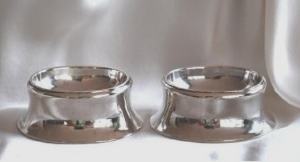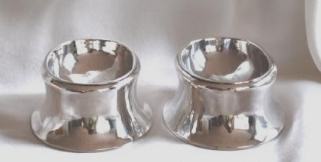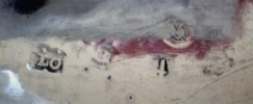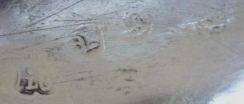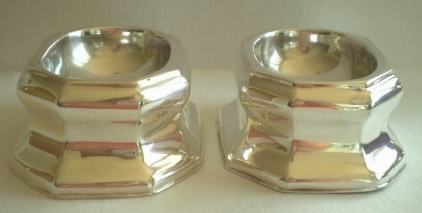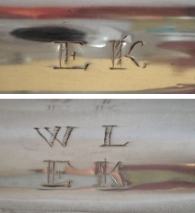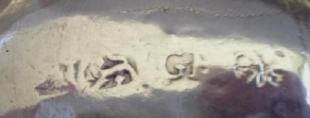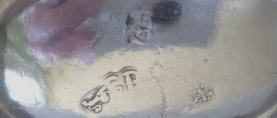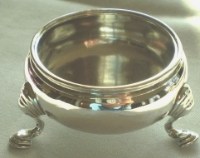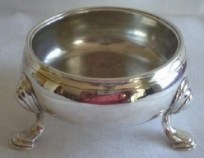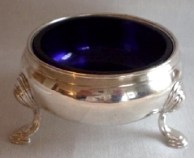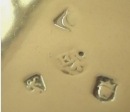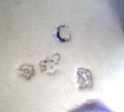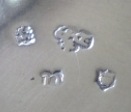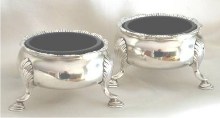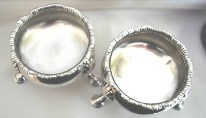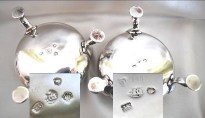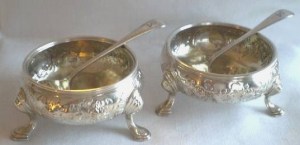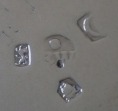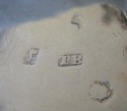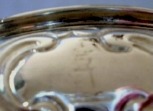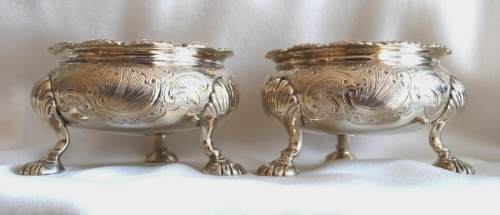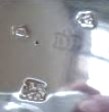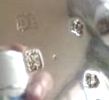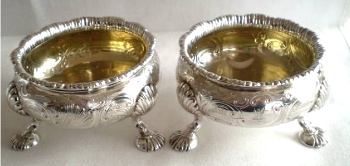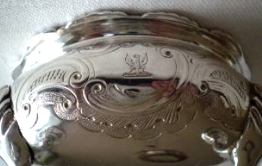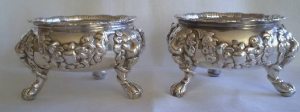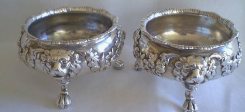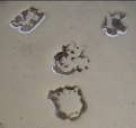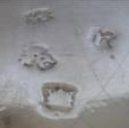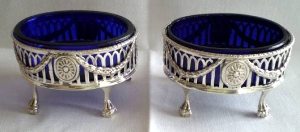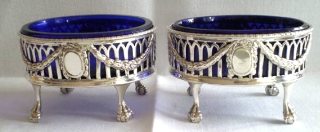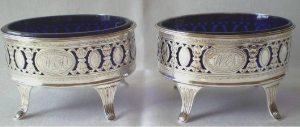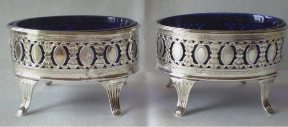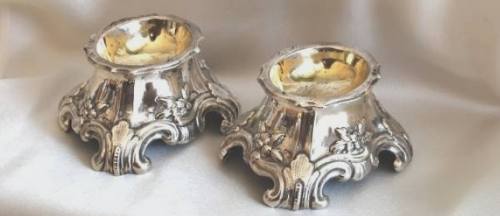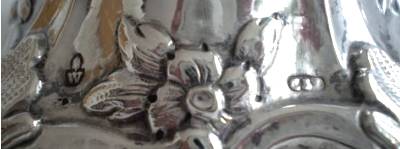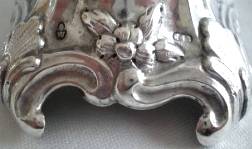by Maria
Entrup-Henemann
|
(click on images to enlarge)
LONDON SALTS OF THE 18TH CENTURY
Through my interest for the fascinating material "salt" I
became aware of the marvellous containers which were created to
keep and present this precious substance in ancient times. I
admired the great medieval salts which had not only a practical
use but, above all, a ceremonial importance, indicating the
relative status of persons by their position at the table in
relation to the large salt. However this use was not very
convenient, so that, at the end of the 17th century, so called
trencher salts were added. Trenchers were individual slabs of
hard bread or wood that served as individual plates. Finally the
large salts disappeared and individual salts were placed next to
each individual trencher or between two of them.
The trencher salts are the early type of salt cellars. There
were no spoons in use: you had to put the salt with your knife (as
long as it was clean) on the rim of the plate. The salts had no
feet and show a wide range of shapes: round, oval rectangular,
triangular or octagonal.
The trencher salts on the pictures below are my earliest ones.
They show an oval plan form with spreading bodies and dished
wells. They were made using Britannia standard silver (958/000)
in London in 1714 by the silversmith William Looker.
Dimensions: 8 / 6 / 3 cm, the combined weight is 112 g.
The Britannia standard silver was introduced in 1696 by
the British government as part of the great recoinage scheme of
William II in the attempt to limit the clipping and melting of
sterling silver coinage. It was thought that requiring a higher
standard on silver manufacture, people would be discouraged to
put in the melting pot the newly issued sterling coins. The lion
passant hallmark was replaced with the figure of a woman called
Britannia and the leopard's head mark for London was
replaced with a "lion's head erased". From June 1720
silversmiths were allowed to use again the sterling silver standard in
their manufacture.
The trencher salts in the pictures below were made just after
this date. In this case, we have a pair of rectangular salts in
cut cornered style, bearing the date letter for 1721 and,
probably, the maker's mark GR, belonging to Gundry Roode (Grimwade
880).
They measure 8,0 / 6,2 / 3,2 cm, weigh together 105 g, and have
monograms: EK on one salt and WL over EK on the other one,
possibly a wedding-gift.
Around 1730 the salt-cellars developed from plain
functional trencher salts to a variety of forms. First were
circular bowls on a collet foot and the more popular form with a
circular body on three or four feet. But salt is silver’s worst
enemy. Therefore, the inner surfaces were gilded or got a glass
liner. Many salts are nearly plain, but most of the fine
examples have rococo design: floral swags, lion masks above the
feet, shells, mermaids and so on.
The pictures below show three plain cauldron salts, made in 1738
by Edward Wood and in 1743 and 1748 by David Hennell I
(left) 6,5 x 3,25 cm, 60 g
(center) 6,4 x 3,5 cm, 45 g
(right) 6,4 x 3,8 cm, 60 g (without
glass, liner probably added later)
Edward Wood was apprenticed to James Roode in 1715, became free
1722 and entered his own mark. We find Wood in the line of
specialist salt cellar makers like his master Roode. In 1728
Wood became master of the young David Hennell, who probably made
more saltcellars in the mid eighteenth century than any other
silversmith.
David Hennell I (1712 - 1785) was – as above mentioned –
apprenticed to Edward Wood in 1728, became free 1735 and entered
his first mark 1736. He was the founder of the
Hennell-Silversmith-Dynasty. He had 15 children. Only five of
them achieved maturity. One of them, Robert, was apprenticed to
his father in 1756 (see below).
We go back to Edward Wood.
Below is illustrated a larger pair, made in 1749, 7 x 4,5 cm,
weighing together 180 g.
They have gadrooned borders, hoof feet with shell knees and
liners (probably added later).
The following pictures show two Cauldron salts with
rococo design: 1738 Edward Wood and 1746 TB (?)
This couple is not really a pair, probably the one of 1746 was
made to accompany the first one.
Both have a shield with a worn or partially removed crest.
The spoons (not sterling but EPNS later addition) have another
crest.
(left) 6,9 x 3,7 cm, 62 g
(right) 6,9 x 3,7 cm, 54 g
The next pictures show a pair of real master salt cellars, made
in 1748 by Daniel Piers.
They measure 8,7 x 4,3 cm, weigh together 270 g (!). They have
an elegant rococo design and an all over engraved C-scroll motif.
Everted, standing gadroon edges. On cast, tripod base with shell
knees and spread hoof feet. Interior gold wash. Each has a
shield with a well detailed crest.
There is no record of apprenticeship or freedom for
Daniel Piers and the first mark was entered in 1746. His work,
though comparatively rare, shows distinction of rococo design
and execution. It is believed that he was probably of Huguenot
extraction.
The following pictures lead us again to David Hennell I with a
pair of large master salts, made in 1752. They measure 8,2 x 5
cm, weigh together 320 g (!) and are decorated with embossed
floral swags and lion masks above the feet.
But times and styles changed. During the Adam period blue
glass liners became general, combined with a pierced design.
Meanwhile James Watt invented the steam engine and
industrialization began. Machine-rolled sheet-silver became
available, saving material because the sheets were very thin.
This advantage influenced not only the design, but also the
price of the salt cellars: they became less expensive. Hester
Bateman was one of the first silversmiths who used this method.
The most popular designs were a circular bowl on a spreading
base or an oval bowl on four feet. The decoration is generally
classical in inspiration, but free floral arabesques are found,
too. Among the designs, which did not involve pierced works, was
one with a boat-shaped bowl, with or without handles, on an oval
base.
The pictures below show a pair of salts, made in 1774 by Robert
Hennell I. They are 8,0 x 6,2 x 5,5 cm, weigh together 130 g (without
glass). One of the glass liners seems not to be the original one.
Robert Hennell I, (1741 - 1811) was the fifth child of
David Hennell I, apprenticed to his father in 1756, free in
1763. The first mark was entered in 1763 in partnership with his
father. A mark alone as smallworker was entered in 1772.
In 1773 he is listed as plateworker and a new mark was
entered as saltmaker.
The next pictures show a pair of salts, made in 1790 by Hester
Bateman, 8,9 x 6,3 x 5,4 cm, weighing together 90 g (without glass).
One of the glass liners seems not to be the original one.
The salts are lovely pierced and engraved and have a shield with
a monogram.
Hester Bateman (1708-1794) was married with John Bateman,
a chainmarker. He died in 1760 leaving all his property
to his wife who entered her first mark in 1761. She had five
children and was the founder of the Bateman-Silversmith-Dynasty.
She retired in 1790 when her sons Peter and Jonathan entered
their own mark.
The next items lead us again to the Hennells.
Below are pictures of a pair of boat shaped salts, made in 1792
by Robert Hennell I, max 14,8 x 5,8 x 8,8 cm, weighing together
190 g. The salts are of elongated shape with elegant loop
handles. Both bear an engraved monogram.
The presented items illustrate the history and the style
changes of salt cellars during the 18th century in London.
I would like to conclude my presentation with a further example
of an 18th century salt, not from London but from Augsburg (Germany).
The shape is a little different from those of London. But this
was a shape quite popular in Continental Europe, from Copenhagen
to Naples.
The pictures below show a pair of salts made between 1773 and
1775 in Augsburg (Germany) by Carl Samuel Betkober, 8,5 x 7,5 x
4,5 cm, weigh, together, 145 g, monogram L.S.
Any suggestion, correction or addition will be welcome.
|
Maria Entrup-Henemann
- 2010 -
|
|
 ASSOCIATION OF SMALL COLLECTORS OF ANTIQUE SILVER
ASSOCIATION OF SMALL COLLECTORS OF ANTIQUE SILVER